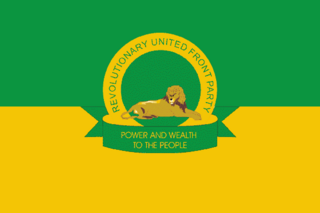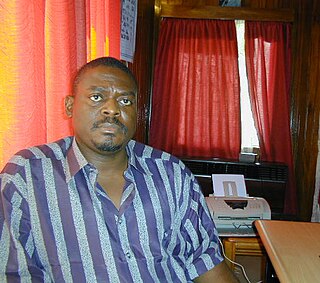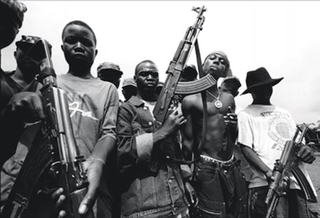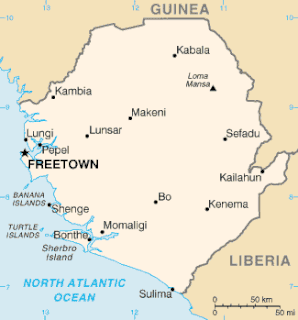
Sierra Leone, officially the Republic of Sierra Leone, informally Salone, is a country on the southwest coast of West Africa. It is bordered by Liberia to the southeast and Guinea surrounds the northern half of the nation. Sierra Leone has a tropical climate with a diverse environment ranging from savanna to rainforests, a total area of 71,740 km2 (27,699 sq mi) and a population of 7,092,113 as of the 2015 census. The capital and largest city is Freetown. The country is divided into five administrative regions which are subdivided into sixteen districts. Sierra Leone is a constitutional republic with a unicameral parliament and a directly elected president serving a five-year term with a maximum of two terms. The current president is Julius Maada Bio. Sierra Leone is a secular nation with the constitution providing for the separation of state and religion and freedom of conscience. Muslims make up about three-quarters of the population, though with an influential Christian minority. Religious tolerance in the West African nation is very high and is generally considered a norm and part of Sierra Leone's cultural identity.
Sierra Leone first became inhabited by indigenous African peoples at least 2,500 years ago. The Limba were the first tribe known to inhabit Sierra Leone. The dense tropical rainforest partially isolated the region from other West African cultures, and it became a refuge for peoples escaping violence and jihads. Sierra Leone was named by Portuguese explorer Pedro de Sintra, who mapped the region in 1462. The Freetown estuary provided a good natural harbour for ships to shelter and replenish drinking water, and gained more international attention as coastal and trans-Atlantic trade supplanted trans-Saharan trade.

Blood diamonds are diamonds mined in a war zone and sold to finance an insurgency, an invading army's war efforts, or a warlord's activity. The term is used to highlight the negative consequences of the diamond trade in certain areas, or to label an individual diamond as having come from such an area. Diamonds mined during the 20th–21st century civil wars in Angola, Ivory Coast, Sierra Leone, Liberia, Guinea, and Guinea-Bissau have been given the label. The term conflict resource refers to analogous situations involving other natural resources.

The Revolutionary United Front (RUF) was a rebel army that fought a failed eleven-year war in Sierra Leone, beginning in 1991 and ending in 2002. It later transformed into a political party, which still exists today. The three most senior surviving leaders, Issa Sesay, Morris Kallon and Augustine Gbao, were convicted in February 2009 of war crimes and crimes against humanity.

Major Johnny Paul Koroma was the head of state of Sierra Leone from May 1997 to February 1998. His alleged death has not been proven as nobody has found his body, hence he cannot be legally deemed to be dead. He was involved in criminal activities such as heavy drug trafficking.

The United Nations Mission in Sierra Leone (UNAMSIL) was a United Nations peacekeeping operation in Sierra Leone from 1999 to 2006. It was created by the United Nations Security Council in October 1999 to help with the implementation of the Lomé Peace Accord, an agreement intended to end the Sierra Leonean civil war. UNAMSIL expanded in size several times in 2000 and 2001. It concluded its mandate at the end of 2005, the Security Council having declared that its mission was complete.

The Second Liberian Civil War began in 1999 when a rebel group backed by the government of neighbouring Guinea, the Liberians United for Reconciliation and Democracy (LURD), emerged in northern Liberia. In early 2003, a second rebel group, the Movement for Democracy in Liberia (MODEL), emerged in the south, and by June–July 2003, Charles Taylor's government controlled only a third of the country.
The Sierra Leone Civil War (1991–2002), or the Sierra Leonean Civil War, was a civil war in Sierra Leone that began on 23 March 1991 when the Revolutionary United Front (RUF), with support from the special forces of Charles Taylor's National Patriotic Front of Liberia (NPFL), intervened in Sierra Leone in an attempt to overthrow the Joseph Momoh government. The resulting civil war lasted 11 years, enveloped the country, and left over 50,000 dead.

Blood Diamond is a 2006 American political war action thriller film directed and co-produced by Edward Zwick and starring Leonardo DiCaprio, Jennifer Connelly, and Djimon Hounsou. The title refers to blood diamonds, which are diamonds mined in war zones and sold to finance conflicts, and thereby profit warlords and diamond companies around the world.

The Siege of Freetown was a battle during the Sierra Leone Civil War. It began when Johnny Paul Koroma took over the power from Ahmad Tejan Kabbah and began a dictatorship. In response, ECOMOG troops, led by Nigeria, helped the Sierra Leone Army to attack and remove Koroma from power and Kabbah was elected back in post. In revenge, Koroma's allies, the RUF, assaulted the city but were forced to retreat.
Jamil Sahid Mohamed Khalil was a Sierra Leonean-Lebanese businessman, diamonds and commodities trader. He attained prominence in the diamond industry across Africa and Antwerp and became an influential figure in the politics of Sierra Leone through his close association with President Siaka Stevens. Jamil also came to dominate other business sectors including fisheries, tourism construction and aviation.
United Nations Security Council resolution 1181, adopted unanimously on 13 July 1998, after recalling all previous resolutions on the situation in Sierra Leone, the council established the United Nations Observer Mission in Sierra Leone (UNOMSIL) to monitor the military and security situation in the country for an initial period of six months until 13 January 1999.

United Nations Security Council resolution 1260 was adopted unanimously on 20 August 1999; after recalling resolutions 1171 (1998), 1181 (1998) and 1231 (1999) on the situation in Sierra Leone, the Council strengthened the United Nations Observer Mission in Sierra Leone (UNOMSIL) by up to 210 additional military observers.

United Nations Security Council resolution 1343, adopted unanimously on 7 March 2001, after recalling resolutions on Sierra Leone and the region, including resolutions 1132 (1997), 1171 (1998) and 1306 (2000), the Council demanded that Liberia end its support for rebels in Sierra Leone and threatened the imposition of wide-ranging sanctions unless the country complied with the Security Council.
The Small Boys Unit (SBU) was a group of children who were forcibly recruited by the Revolutionary United Front (RUF) as militants during the Sierra Leone Civil War. The war began in 1991, when the RUF desired to overthrow the government and gain control of the diamond mines, a major source of revenue for the country. In 1998, 25% of the soldiers fighting in the war were under 18, and of those, 50% were abducted and 28% were under the age of 12. The war ended with a ceasefire on 18 January 2002.
The United Kingdom began a military intervention in Sierra Leone on 7 May 2000 under the codename Operation Palliser. Although small numbers of British personnel had been deployed previously, Palliser was the first large-scale intervention by British forces in the Sierra Leone Civil War. In early May 2000, the Revolutionary United Front (RUF)—one of the main parties to the civil war—advanced on the country's capital, Freetown, prompting the British government to dispatch an "Operational Reconnaissance and Liaison Team" (ORLT) to prepare to evacuate foreign citizens. On 6 May, the RUF blocked the road connecting Freetown to the country's main airport, Lungi. The next day, British soldiers began to secure the airport and other areas essential to an evacuation. The majority of those who wished to leave were evacuated within the first two days of the operation, but many chose to stay following the arrival of British forces.
During the Sierra Leone Civil War gender specific violence was widespread. Rape, sexual slavery and forced marriages were commonplace during the conflict. It has been estimated by Physicians for Human Rights (PHR) that up to 257,000 women were victims of gender related violence during the war. The majority of assaults were carried out by the Revolutionary United Front (RUF). The Armed Forces Revolutionary Council (AFRC), The Civil Defence Forces (CDF), and the Sierra Leone Army (SLA) have also been implicated in sexual violence.
Roughly 10,000-14,000 child soldiers in Sierra Leone fought between 1991 and 2002 in the Sierra Leone Civil War. Children fought on both sides of the conflict. Nearly half of the Revolutionary United Front (RUF), and a quarter of the governmental armed forces consisted of children aged 8–14 years old.
The Sierra Leone's Truth and Reconciliation Commission was a truth commission created as part of the Lomé Peace Accord, which ended the 11-year civil war conflict in Sierra Leone in July 1999.

The United Nations Observer Mission in Sierra Leone (UNOMSIL) was a United Nations peacekeeping operation in Sierra Leone from 1998 to 1999 that was established with the passage of United Nations Security Council Resolution 1181. Its mission was to monitor the military and security situation in Sierra Leone. The mission was terminated in October 1999, when the Security Council authorized deployment of a new, and significantly larger peacekeeping operation, the Nations Mission in Sierra Leone (UNAMSIL).